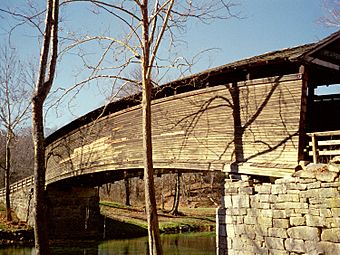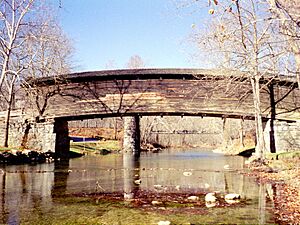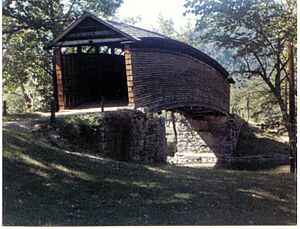Humpback Covered Bridge facts for kids
|
Humpback Covered Bridge
|
|

The Humpback Covered Bridge is one of the last remaining bridges of its type in the U.S.
|
|
| Location | Alleghany County, Virginia |
|---|---|
| Nearest city | Covington, Virginia |
| Built | 1857 |
| NRHP reference No. | 69000219 |
Quick facts for kids Significant dates |
|
| Added to NRHP | October 1, 1969 |
| Designated NHL | October 16, 2012 |
The Humpback Covered Bridge is a special old bridge in Virginia, United States. It's called "humpback" because it's built higher in the middle, like a camel's hump! This bridge was built in 1857. It is the oldest covered bridge still standing in Virginia.
The bridge crosses a small stream called Dunlap Creek. This creek flows into the Jackson River. The bridge is about 109 feet (33 meters) long. The middle part of the bridge is 4 feet (1.2 meters) higher than its ends. You can find this unique bridge near the city of Covington, Virginia.
Contents
Why Covered Bridges?
People started building covered bridges in the early 1800s. They learned that adding a roof over wooden bridges made them last much longer. Without a roof, the wooden parts of a bridge, like the floor and supports, would only last about ten years.
With a roof, these wooden bridges could last ten times longer! The roof protected the wood from rain, snow, and sunlight. These elements can make wood rot and weaken over time.
Sometimes, covered bridges were called "kissing bridges." This was because the private space inside the bridge allowed people traveling by horse and buggy to share a quick kiss without anyone watching!
Bridge History
Three bridges stood in almost the same spot before the Humpback Covered Bridge. The first bridge was built in the 1820s. A big flood destroyed it in 1837. Another bridge was built the next year, but it was also ruined by a flood in 1842. The third bridge fell apart in 1856. This was due to heavy use and damage from weather.
None of these earlier bridges had a hump or a roof. They were all part of a busy road called the James River and Kanawha Turnpike. This road connected the Shenandoah Valley with the Allegheny Mountains and places further west.
The current Humpback Covered Bridge was built in 1857. Its designers hoped that covering and arching the bridge would make it last longer. The roof would protect the wooden floor from moisture and sunlight. The arch would help protect the middle of the bridge from future floods. Back then, bridge floors couldn't be painted to protect them. Horse and wagon traffic would quickly wear off any paint.
Bridge Use and Preservation
The Humpback Covered Bridge was used from 1857 until 1929. At that time, a new steel bridge was built nearby for U.S. Route 60 in Virginia. The old covered bridge was no longer used for traffic. However, a local farmer sometimes used it to store hay bales until the early 1950s.
In 1953, local groups like the Covington Business and Professional Women's Club raised $5,000. The Virginia Highway Department matched this money. They bought five acres of land around the bridge. In 1954, a small park was opened, making it easier for people to visit the bridge.
The Humpback Covered Bridge became very important. On October 1, 1969, it was added to the National Register of Historic Places. In 2012, it was named a National Historic Landmark. This means it's a very special place in American history.
How it was Built
Most covered bridges were made from the strongest wood available. For the Humpback Covered Bridge, builders used white oak and hickory wood. Even today, most of the original hand-cut support timbers and floorboards from 1857 are still there. However, the walls and roof have been replaced several times over the years.
Bridge floors were usually made of wide planks. These planks were often a foot (30.5 cm) or more wide and 4 to 6 inches (10 to 15 cm) thick. Most of the main support beams are at least a foot thick. The builders used handmade pins made from honey locust wood to connect parts of the supports.
The bridge's supports use a special curved design called a "multiple kingpost-truss system." This unique design is not found in any other wooden bridge still standing in the U.S. The Humpback Covered Bridge is truly one-of-a-kind!
Visiting the Bridge
The Humpback Covered Bridge is located about 3 miles (4.3 km) west of Covington, Virginia. You can find it off Rumsey Road (SR 600), near U.S. Highway 60. If you're traveling on Interstate 64, exit number 10 is less than a mile from the bridge.
The park around the bridge is about 5 acres (2 hectares) big. It has a parking area, restrooms, and a picnic area. You can also easily get to Dunlap Creek from the park. It's a great place to visit and see a piece of history!




